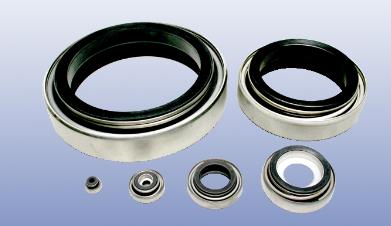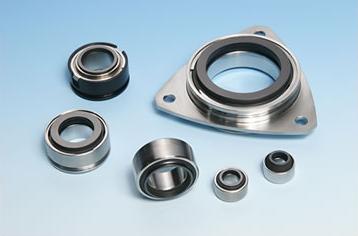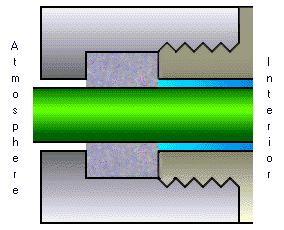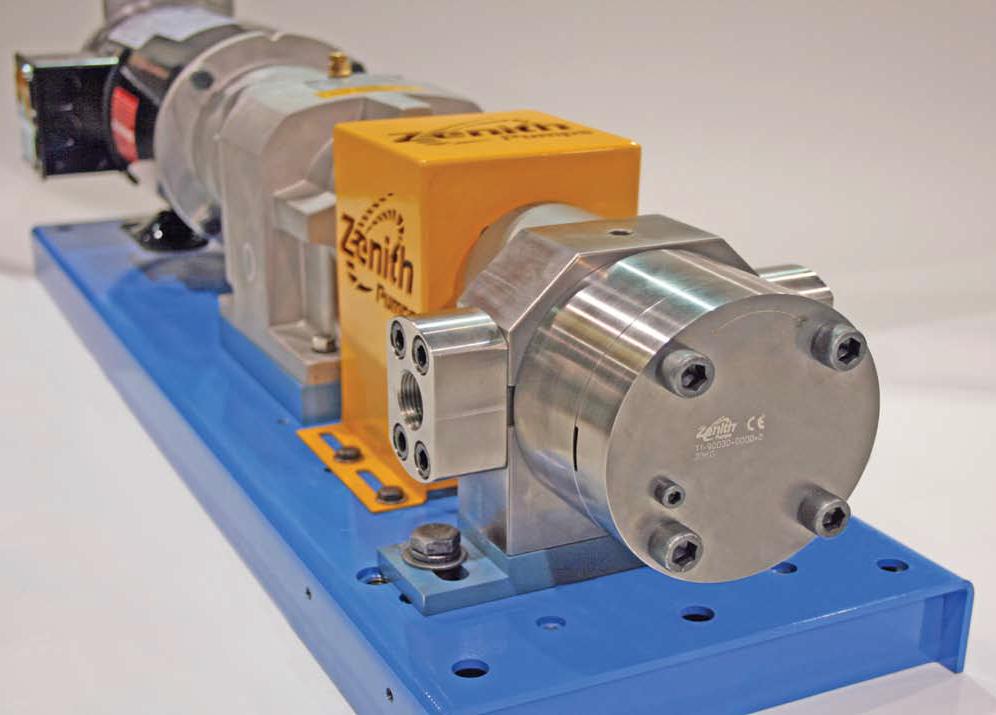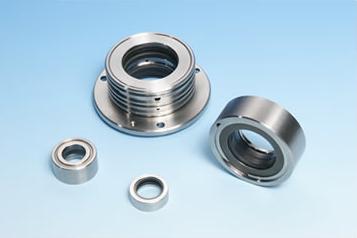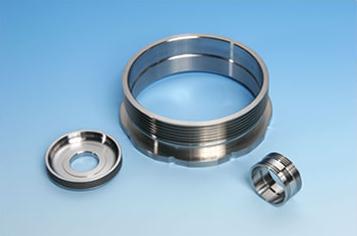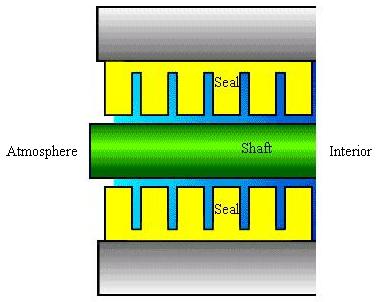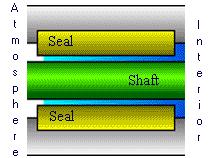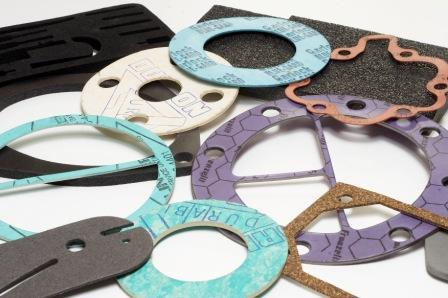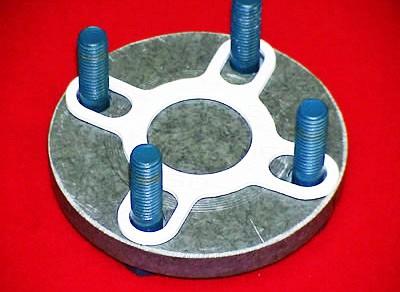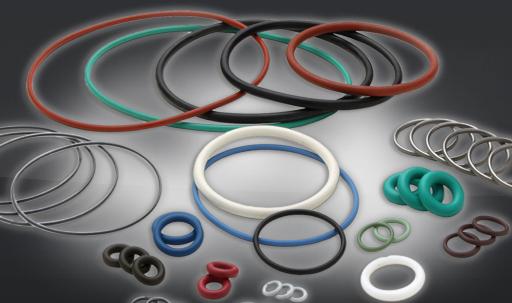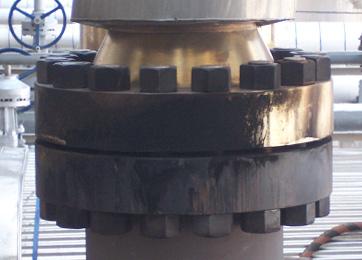The main functions of seals are to contain pressure, maintain vacuums, and control unwanted particles from collecting in machinery.
Dynamic Contacting
Dynamic contacting seals are used with sliding surfaces. They are found in a number of applications.
General Information
Dynamic contacting seals are used to prevent particles from entering specific areas in equipment. These seals are used in shafts that rotate or oscillate.
Radial lip seals are made of elastomer and made to form to their surroundings, while mechanical face seals consist of a set of simpler seals, that seal against each other. Dual-mechanical seals are made of two sets of seal faces with a barrier of incompressible fluid located in the space between them. Packing seals use different materials, such as graphite and cotton, to form a seal between surfaces.
Less common than the above four, diaphragm seals are membranes that transmit force or pressure and can be attached to stationary or moving parts. They separate fluids and/or prevent fluids from entering chambers in machinery. Piston rings and steel rings are also contacting seals.
Equipment Design
Radial Lip
Radial lip seals are some of the most used and effective seals. Even though there are many different designs, all radial lip seals follow the same basic principle. An elastomeric beam-like member is bonded to an outer case. A garter spring is often included on the member to help compensate for any changes in the elastomeric properties due to exterior conditions.
As seen in the animation, while the shaft (green) rotates, oscillates, or reciprocates, the elastomeric member (yellow) and the garter spring (brown) flex to accommodate the motion, creating a dam-like seal. The outer diameter of the shaft is larger than the inner diameter of the elastomeric member, and the difference between these two measurements is called interference. When the seal is installed, this member is stretched backward, placing a force between the shaft and the seal.
Mechanical Face Seals
As seen in the animation, a mechanical face seal is a complex seal composed of a series of simple seals. One primary steel ring (light gray), called the seal head, is attached to the shaft (green) and rotates along with it. The second primary ring (yellow), the seal seat, is attached to the housing and is stationary. When the shaft rotates, the resulting force turns the compression spring (dark blue) which forces a sealing ring (orange) against the seal seat, creating the seal. Acting like bearings, these components are subject to heat and frictional wear and must be lubricated to remain efficient. This lubrication may leak, but only in small amounts due to the secondary seals (black), which are most often o-rings.
The contact between the two rings is continuously maintained by pushing forces in the axial direction. These forces are either hydraulic or mechanical or both. This means the seal uses the fluid it is sealing along with a mechanical process to press the sealing rings together to create the seal.
Dual-Mechanical Seals
Dual-mechanical seals are used to prevent leakage from the fluid side of pumps into adjacent bearing housings and the environment. A barrier fluid, usually an incompressible one, is located in the space between the two sets of seal faces. This fluid can either be circulated slowly by thermal convection, or it can be pumped through a heat-exchanger loop. Because thermal convection is a slow process and its cooling action is hard to predict, this is the least effective of the two methods. When a dynamic pumping action is transmitted to the barrier fluid in the dual-mechanical seal, more fluid is moved and more heat per unit time is dissipated. However, seal face temperatures ought to be kept relatively cool and below the point of vaporization of the liquid film between the faces. For this reason, many companies still use cooler operations, such as thermal convection, despite the fact that they are not the most efficient methods.
Dual-mechanical seal failures, such as large spills of hazardous liquids, could lead to fires or explosions. The loss of flow of the buffer liquid through the seal is one common cause of failure. To avoid this problem, a buffer-liquid seal system, consisting of a circulating pressurized reservoir with an internal low-level alarm and cooling coil, can be used. When a seal failure occurs, the pressure of the reservoir will push the liquid either into the process fluid or out of the seal on the low-pressure side. The liquid level in the reservoir will show as abnormal and the alarm will go off. This alarm is interlocked with the pump motor, so when the alarm goes off, the pump shuts down. In tandem dual-mechanical seals, the buffer liquid is usually at atmospheric pressure or slightly higher. A high-pressure or liquid-level switch in the reservoir shuts down the pump motor in case of inner seal failure, to prevent the process fluid from flooding the reservoir.
Packing
Packing seals contain material inserted into gaps into a stuffing box cavity between the shaft and its housing. The packing is tightened by a metal ring, plate, or spring that is attached to a casing through which the shaft is passed.
Packing materials, and the way they are packed, can be chosen from a variety of materials, including fibers, metals, and plastics. Although there are no set guidelines for choosing a packing material, operating information is provided by most manufacturers. Packing can be made from fibers, metals or plastics. Examples of fibers include Teflon® braided yarn, cotton twisted yarn, and molded cloth. Metal packing is usually foil or wire. Examples include copper knitted wire and spun aluminum foil. Plastic packing can be lubricated or dry bonded, such as coils and molded rings.
Usage Examples
Radial lip seals are used primarily to exclude contaminants from equipment with rotating shafts. They can be found on vehicle wheels and drive axles. They are also used in other devices in which grease is used as a lubricant.
Radial lip seals, often called oil seals, are used primarily to exclude contaminants from equipment with rotating shafts. They can be found on vehicle wheels and drive axles. They are also used in other devices in which grease is used as a lubricant. The common metal-cased seals include rubber sealing inside a carbon steel case. The biggest problem with metal cased designs is the exposed metal can corrode when exposed to the environment or corrosive materials it is sealing. Rubber seals address the corrosion issues but lack the rigidity of the more common metal-cased seal. However, issues arise with metal designs as corrosion may occur when exposed to the atmosphere or corrosive materials. An alternative design is an all-rubber seal. Rubber seals address the corrosion issues but lack the rigidity of a metal encased seal.
Mechanical face seals were originally used in the automotive industry for engine coolants. Now mechanical face seals are used in the chemical, petrochemical, and utility industries. They can also be found in centrifugal pumps.
Packing seals are used in many applications, depending on the type of packing used. One very typical use of packing seals is to provide a seal for reciprocating and rotating shafts, such as in valves and pumps. Packing seals can be found in gear pumps, as shown here, that are used in the chemical and petroleum industries.
Advantages
- Radial lip seals are easy to install.
- Mechanical face seals can handle all types of fluids.
- Dual-mechanical seals have a buffer-liquid seal system that prevents leakage from the fluid side of pumps to adjacent bearings and the environment.
- Packing seals can be replaced without disassembly of the housing equipment.
Disadvantages
- Radial lip seals require good contact between the lip seal and shaft for the seal to be efficient.
- Mechanical face seals must be replaced often due to wear.
- Packing seals are often packed too tightly, resulting in premature wear.
Dynamic Non-Contacting
Non-contacting seals allow minimal fluid leakage. This creates a pressure drop that is used to seal rotating shafts without contact.
General Information
Non-contacting seals have a small gap between the seal and the shaft that minimizes wear.
Labyrinth seals, such as the ones shown below, allow a bit of leakage and use a series of dips and chambers to create a seal while bushing seals use a singular, solid seal. Hydrodynamic seals use a series of grooves to create a pump to make a seal.
Less common non-contacting seals include magnetic seals, that use a magnetized fluid trapped by a magnetic field in a gap much like a labyrinth seal. The particles in the magnetic fluid collide with those in the sealed fluid and keep the particles in suspension for a calculated amount of time. It is used to prevent leakage of gases or entrance of contaminants. Centrifugal and hydrostatic seals are also non-contacting seals.
Equipment Design
Labyrinth
Labyrinth seals are used with high-speed rotation shafts when a small amount of leakage is acceptable. Labyrinth seals force fluid through a series of chambers separated by teeth, creating a decrease in both pressure and flow rate, as shown in the schematic.
When used properly, labyrinth seals do not require any lubrication.
Brushing
There are two types of bushing seals: fixed and floating. A bushing is a ring of metal or composite inserted in a plate or other type of equipment to relieve the wear on a shaft or other piece of machinery. Both bushing seals create very small gaps between the seal and shaft, resulting in minimal leakage. Floating seals can be positioned very close to the shaft since they can move more than fixed seals to accommodate shaft rotation.
Hydrodynamic
In hydrodynamic seals, sometimes referred to as “visco” or “windback” or “positive action” seals, the shaft acts as a pump, as shown in the animation. Viscous fluid (blue) is pumped back toward a sump by helical grooves (dark blue) in the rotating shaft (light gray). This pumping of the fluid maintains a pressure that prevents the fluid from reaching the atmosphere, effectively creating a non-contacting seal.
Usage Examples
Labyrinth seals are typically used in centrifugal compressors, such as the one shown here, and steam turbines. The shafts on steam turbines and centrifugal compressors turn very rapidly and labyrinth seals result in very little damage to the shafts.
Hydrodynamic seals are used in applications requiring rotating shafts. Such applications include oilfield drilling and production tools. The artificial pump cartridge shown below prevents crude oil leakage into the environment.
Bushings seals are used to protect the lubrication for other seals from contacting abrasive fluids. They can be found in conveyor rollers to prevent grease from interacting with other roller parts. Bushing seals allow only a minimal amount of fluid to leak into neighboring components.
Advantages
- All non-contacting seals can be used with high rotational shafts.
- Labyrinth seals require no lubrication.
- Bushing seals leak less than labyrinth seals.
- Hydrodynamic seals can operate at a wider range of pressures and temperatures, better than most contacting seals.
Disadvantages
- All non-contacting seals have some leakage.
- Labyrinth seals require an investment in piping.
- Bushing seals can only be used in liquid applications and also require an investment in piping.
- Hydrodynamic seals require a large amount of heat dissipation.
Static
Static seals are used when there is no motion between the two sealed surfaces.
General Information
Static seals are used to seal connections with little or no relevant motion between parts. Typical types of static seals are gaskets and o-rings. Gaskets, shown to the right, provide a tight seal for many piping applications. O-rings, shown below to the left, are circular seals that come in many sizes and are used in many of the same applications as gaskets. Sealant fluids can also be used as static seals and are grouped as hardening and non-hardening sealants. Bellows and pseudo-static seals are also static seals.
Equipment Design
Gaskets, such as those shown below, are flat pieces of metal, plastic, or composite cut to the appropriate shape to tightly seal gases, liquids, or solids in various applications. The gasket shown to the right is a reduced area gasket. The reduced area results in a reduction in the bolt torque necessary to effect and maintain a seal.
(Copyright Seal & Design Inc., Clarence, NY)
To choose the proper gasket material, it is necessary to check the internal pressure requirements.
O-rings are circular seals made of elastomer, plastic, or metal, as shown below. The most common are those made of elastomer. When they are compressed, elastomer o-rings change shape to keep the seal. Usually, o-rings can be reused, but if subject to any type of high pressure for long periods of time, they will not return to their original shape.
Usage Examples
Gaskets are commonly used in machinery, equipment, containers, piping systems, and almost any other sealing application. Gaskets can be found between the flanges on a pipe to protect against leaking.
O-rings can be found in many types of machinery, from automobile parts to space shuttles. Physicist Richard P. Feynman discovered that the Challenger space shuttle exploded due to a fault with the o-rings used on the rocket boosters. The seals were used to seal a gap that contained hot gas. The gap expanded as pressure built in the rocket, and the seal had to conform to the gap quickly enough to maintain the seal.
Morton Thiokol engineers found that most times at temperatures below 53°C, the o-rings would not expand to seal the gap, and subsequently would release the hot gases. The outside temperature on the day of the Challenger flight was 29°C, resulting in a flame outside the shuttle that led to the explosion.
Advantages
- Gaskets have relatively low leakage.
- O-rings are found in the widest variety of sizes, ranging from very large (m) to almost microscopic (µm).
Disadvantages
- Gaskets are sensitive to pressure and temperature fluctuations.
- O-rings cannot be subject to high pressure for too long because they will not return to their original shape.
Acknowledgements
- Cyclam SAS, France
- NASA Glenn Research Center
- NASA Kennedy Space Center
- Qualiseal Technology, Harwood Heights, IL
- Seal & Design Inc., Clarence, NY
- TurnaSure LLC, Langhorne, PA
References
- Booser, E. Richard. CRC Handbook of Lubrication (Theory and Practice of Tribology). Boca Raton, FL: CRC Press, Inc., 1984. Print.
- Booser, E. Richard. Tribology Data Handbook. Boca Raton: Society of Tribologists and Lubrication Engineers, 1997. Print.
- Brink, Robert V, Daniel E. Czernik, and Leslie A. Horve. Handbook of Fluid Sealing. New York: McGraw-Hill, Inc., 1993. Print.
- Buchter, H. Hugo. Industrial Sealing Technology. New York: John Wiley & Sons, 1979. Print.
- Dahlheimer, John C. Mechanical Face Seal Handbook. Philadelphia: Chilton Book Company, 1972. Print.
- Feynman, Gweneth, Feyman, Richard P., and Leighton, Ralph. What Do You Care What Other People Think? New York: W.W. Norton & Company, Inc, 1988. Print.
- Grossel, Stanley S.”Pump Hazardous Liquids Safely.” Chemical Engineering February 2008: 38-39.Print.
- Horve, Les. Shaft Seals for Dynamic Applications. New York: Marcel Dekker, Inc., 1996. Print.
- Martini, Leonard J. Practical Seal Design. New York: Marcel Dekker, Inc., 1984. Print.
- Roddis, Alan. “Seal-Fluid-Circulation Devices: Understanding the Differences.” Chemical Engineering January 2008: 44-45. Print.
Developers
- Julie Messacar
- Jonathan West
- Steve Wesorick
- Abigail Nalbandian
- Kelsey Kaplan
- Keith Minbiole

